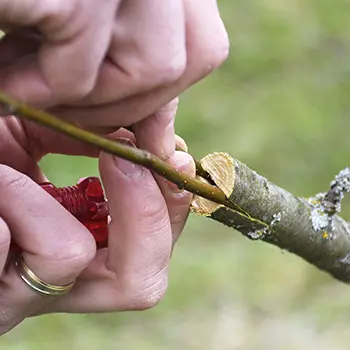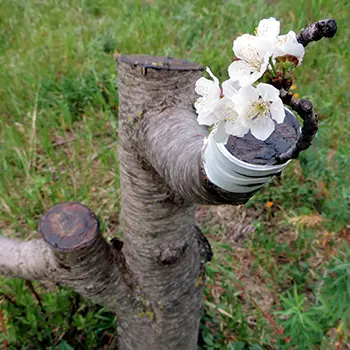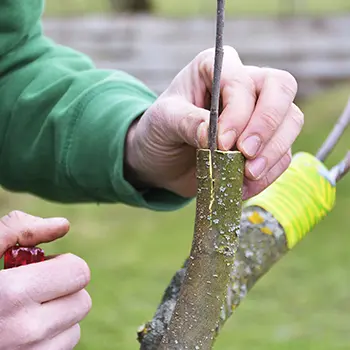When it comes to fruit trees, grafting is simply a way of life. In fact, if you take a look at the fruit trees springing up at your local nursery right now, you’ll see grafting cuts (once you can recognize them) near branch joints on many, many trees and there is certainly nothing wrong with that approach. While some are grown from seed (usually specially bred seeds specifically made for growing new trees), almost all fruit trees are or have been grafted at some point. Interested in learning more and maybe doing a little grafting of your own? Let’s cut straight to the point!
Why Grafting?
Few fruit tree seeds grow true from generation. That means if you plant the seeds of a Red Delicious apple straight from the grocery store, you likely will get a tree that looks nothing like the tree the fruit came from.
That means if you plant the seeds of a Red Delicious apple straight from the grocery store, you likely will get a tree that looks nothing like the tree the fruit came from.
Why is that? Because many fruit trees cannot self-pollinate. We’ll stick with apples. Apples cannot self-pollinate as bean plant can. Apples that can inter-pollinate are planted near each other and used specifically for the purposes of pollinating each other and propagating fruit. There are, in fact, breeds of apples that cannot pollinate their own breed or very special crossbred apples whose seeds would not make an appealing fruit.
To get more trees in these cases, we need to graft mature roots to young stems (or early branches) and help those special species flourish. There are other ways to do this, including carefully modifying seeds, but grafting is the tried-and-true method that farmers have been using for generations. And it’s the method that we’ll be experimenting with later in this article.
What Fruits Graft Well?
Any fruit that has a woody vine or almost any fruit tree. We’ll cover multiple-fruiting trees at the end of this article, but please note we do not suggest that you attempt to make those. They are often complementary plants to one another but are not always the best suited and can be very hard to grow.
Will This Speed Up My Ability To Get Fruit?
The answer here is: maybe.
In slow-growing fruiting plants, you may be able to get a solid yield out of a grafted tree a year or two after grafting as opposed to 3-5+ years down the road. The chances of that happening depend a lot on the health of the branch that you take, the weather, how you care for the tree, and diseases in the general area. Grafting can speed up the flowering and fruiting process, but it isn’t guaranteed with all potential grafting plants. Look at species (or variety) specific guides for what you intend to graft and see if this is the case. Unfortunately, there are literally millions of different combinations and we cannot possibly cover them all without giving you a whole novel right here.
Let’s Get Grafting
We’re going to pretend that you already have your rootstock and your scion grafting wood. Scion grafting wood is from the tree you wish to grow. Your rootstock is from the tree that was mature and will be helping your new branch to grow.
Trim your scion wood so that the end is at a point, rather like a pencil. You may choose to do this with a knife or with trimming scissors. Personally, I use pruning shears simply to make my cuts as exact as possible.
Now, trim the rootstock you wish to use in a way that allows the scion wood to seat neatly into the notch you’re creating, much as if you were seating an arrow into a holder.
Look closely as you do this. You will see faint lines inside the bark. These lines must line up perfectly so the tree will recognize that it needs to heal this area. If all the lines do not match, simply be aware that most need to (over 75%) for successful grafting.
Related: Dwarf Fruit Trees You Can Grow In A Tiny Space
Have someone hold the freshly grafted tree in place and wrap the area in grafting tape. We prefer grafting tape to the old-fashioned twine method simply because it helps create a better seal. Once you’ve fully taped the grafted tree, cover the area with your favorite tree-sealing or “tree healer” medication. There are thousands of these on the market and many are area-relevant enough that we won’t make any specific suggestions. I simply prefer one that says it is waterproof because that means you won’t lose moisture from the plant and you deal with less potential rot at the grafting site.
Be aware that trees that are grafted will always be weak in the grafting spot; or weaker than the rest of the tree. We strongly recommend not placing grafted trees anywhere near houses or other structures or belongings that may be damaged in case of tree collapse. It is very rare that grafted trees lose branches, but it does happen and we would prefer nothing happen to you or your personal belongings.
If possible, use a grafting tape that simply dissolves as the tree grows. This makes it a great deal easier to use than the ones where you must remember which tree is grafted and go remove the tape before it strangles the young trees.
Multi-Fruit Type Trees
Most of these trees are sort of a gimmick. They’re a fun experiment, but they often do poorly because the needs of a lemon tree differ from the needs of a plum tree. You’ll also find that these multi-fruit trees seem to be more susceptible to diseases and insect invasions. As mentioned above; insects will happily invade a plum tree and find peaches and cherries, too? Wow, what a bounty! Time to rip this tree apart and completely destroy it.
If you happen across a multi-fruiting tree or are gifted one, feel free to give it a whirl. Or, if you’ve had experience with them exclusively and found it a very positive experience, feel free to talk to us about it in the comments down below.
You may also like:
The Most Dangerous Tree In The U.S.
An Insanely Effective Way to Build a 5 Year Food Stockpile (Video)
The One Tree That Every Homesteader Should Plant









